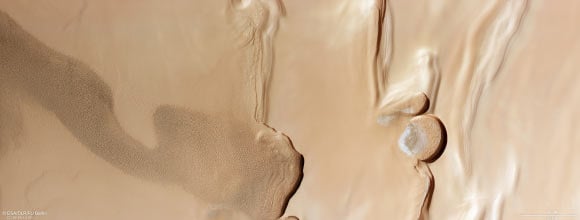According to Sci-News, images and other data obtained by Mars Express while flying over the North Pole of Mars show that the permanent ice cap here is a stack of layers of water ice and dust up to 3 km thick, about 1,000 km in diameter.
They are divided into four thick overlapping layers of varying thickness, each thick layer consisting of several finer thin layers.

Planum Boreum, an interesting region full of water ice at the North Pole of Mars - Photo: ESA
Like "storytelling" tree rings, these sediment layers contain information about the climate of the past million years on Mars.
Each layer of sediment is a precipitation of dust and water from the atmosphere and is due to direct frost formation. They consist mainly of ice, with fine dust sediments accounting for 10 to 15% of the total.
According to the European Space Agency (ESA), the "owner" of the Mars Express spacecraft orbiting Mars, the new data reflects changes in Mars' orbit as well as the tilt of the planet's rotation axis.
Our Earth sometimes changes its orbit slightly, its axis of rotation is off-center... But the instability of Mars is even higher, which may indicate that the climate of this world in many periods of change was more severe than that of Earth.
Because the change in the rotation axis leads to changes in solar radiation for each point on the planet, especially at the poles.
In its current position, the Arctic ice cap is growing rapidly. It will completely disappear in the summer.
“The terrain around Mars' north pole, known as Planum Boreum, is fascinating,” the ESA team wrote.
In the photo they just released, the left side is dominated by a vast, elongated stretch of undulating sand dunes, stretching over 150 km in this frame alone.
This wrinkled, chaotic appearance is in stark contrast to the flatter, more pristine terrain visible to the right.
Meanwhile, the smooth area shows no obvious signs of erosion and is not pockmarked by impact rocks from space, a sign that the surface is very young, possibly even rejuvenated every year.
Between these two extremes are two semicircular cliffs, the larger of which is about 20 km wide. Within the curved part of these cliffs are frost-covered sand dunes.
They are called polar troughs, a feature created when wind blows into and erodes the surface.
Not only is it strange and interesting, the detailed data about an area with water ice is a "treasure" that Mars Express has sent to Earthlings.
In the future, leading space agencies such as NASA and ESA plan to establish a base on Mars. At that time, water ice will become a "source of life", where they can find a way to turn it into drinking water and fuel.
Furthermore, the presence of water on another planet is necessary to infer that the planet is habitable.
Based on current scientific evidence, most scientists believe that Mars once supported life several billion years ago, when its climate was similar to Earth's and had not yet been turned harsh by unfortunate planetary evolution.
Some scientists even hope that some form of extreme life, to this day, still lurks somewhere on this planet.
Source


![[VIDEO] - Bustling Ngoc Linh ginseng market in 2025](https://vphoto.vietnam.vn/thumb/1200x675/vietnam/resource/IMAGE/2025/8/2/4047d6bb8be947a29b8e5cafd519164a)




































































































Comment (0)